
How to Use MAX4617 Analog Multiplexer: Examples, Pinouts, and Specs
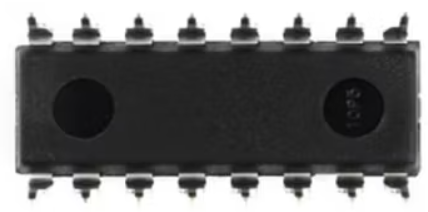
 Design with MAX4617 Analog Multiplexer in Cirkit Designer
Design with MAX4617 Analog Multiplexer in Cirkit DesignerIntroduction
The MAX4617, manufactured by Analog Devices, is a low-voltage, high-speed analog multiplexer designed to route multiple analog signals to a single output. It features low on-resistance, low distortion, and fast switching times, making it ideal for applications requiring high signal integrity and rapid signal routing. The MAX4617 is commonly used in audio, video, and data acquisition systems, as well as in test and measurement equipment.
Explore Projects Built with MAX4617 Analog Multiplexer
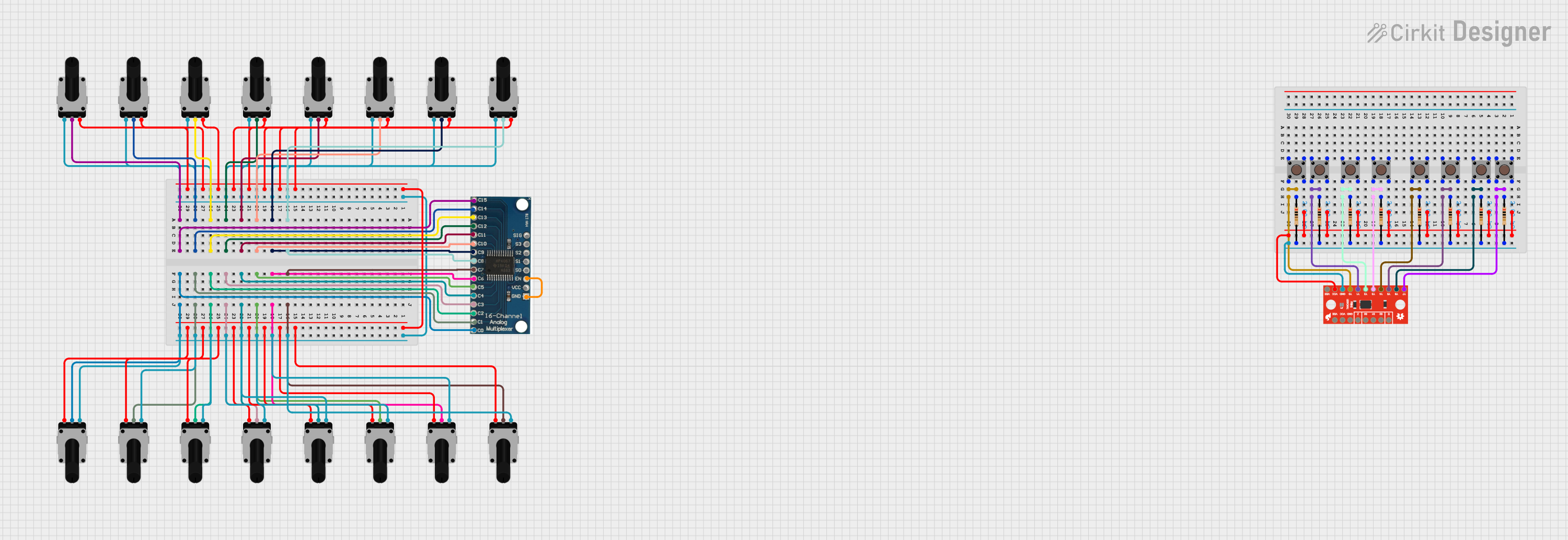
 Open Project in Cirkit Designer
Open Project in Cirkit Designer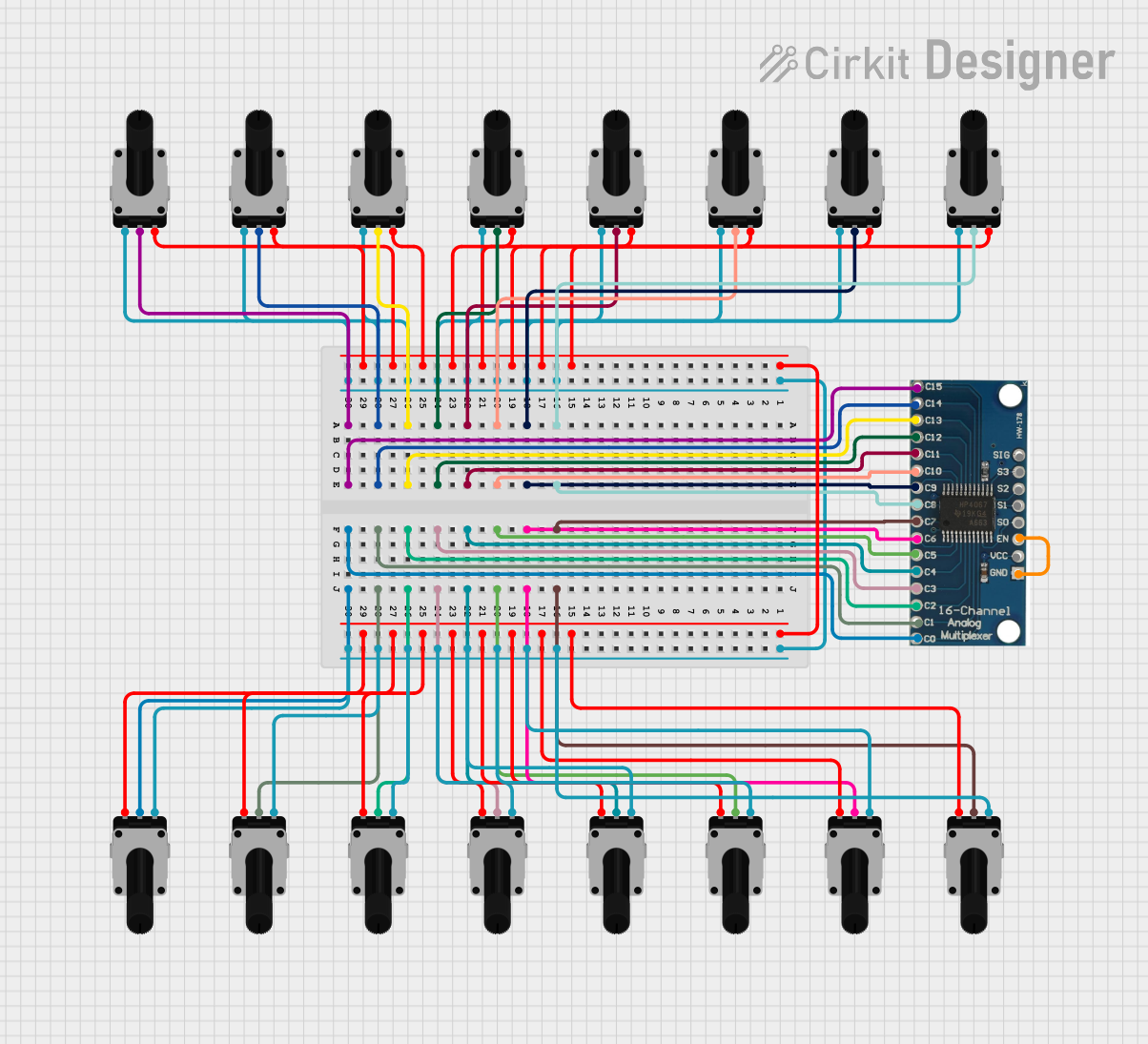
 Open Project in Cirkit Designer
Open Project in Cirkit Designer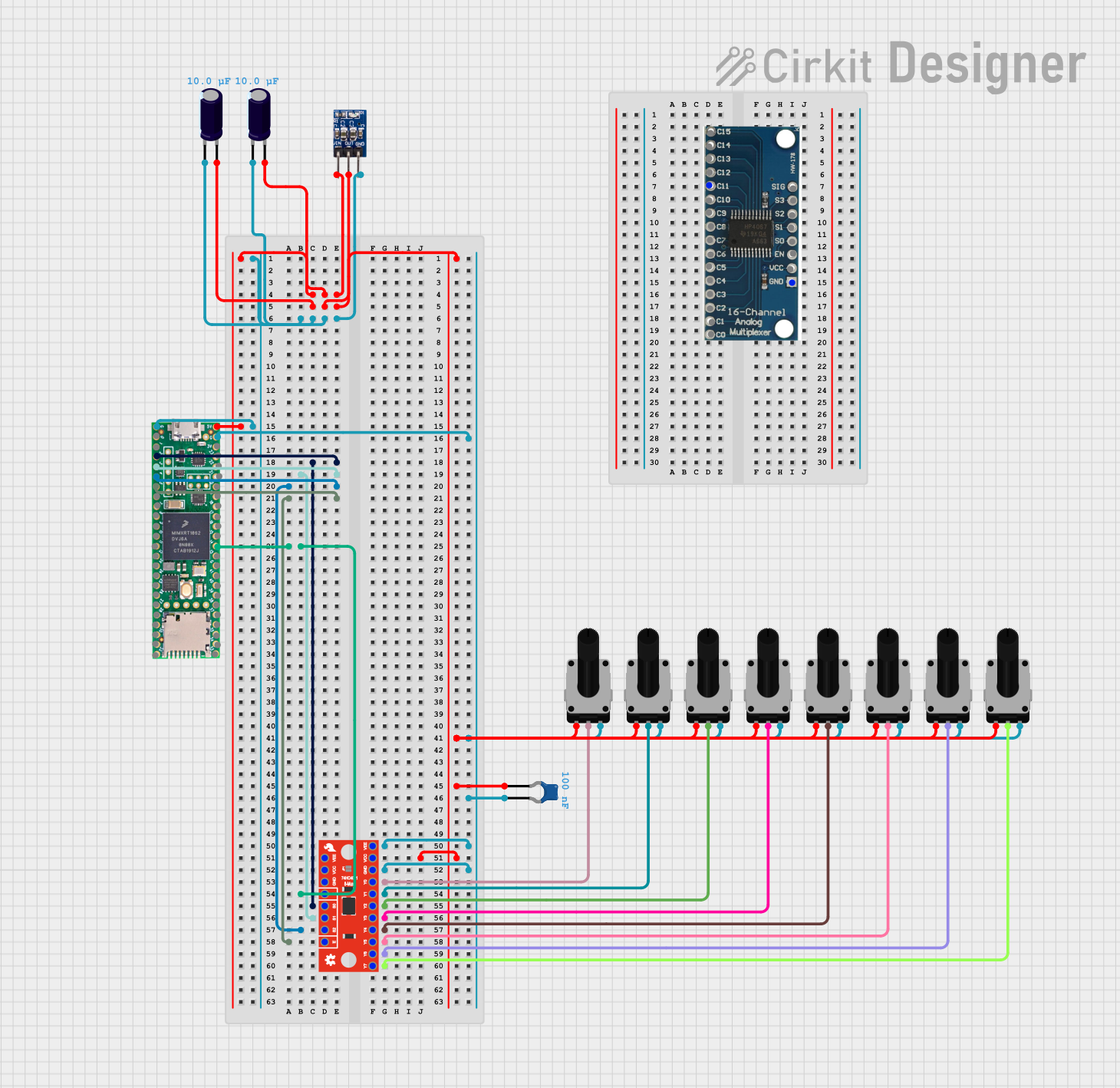
 Open Project in Cirkit Designer
Open Project in Cirkit Designer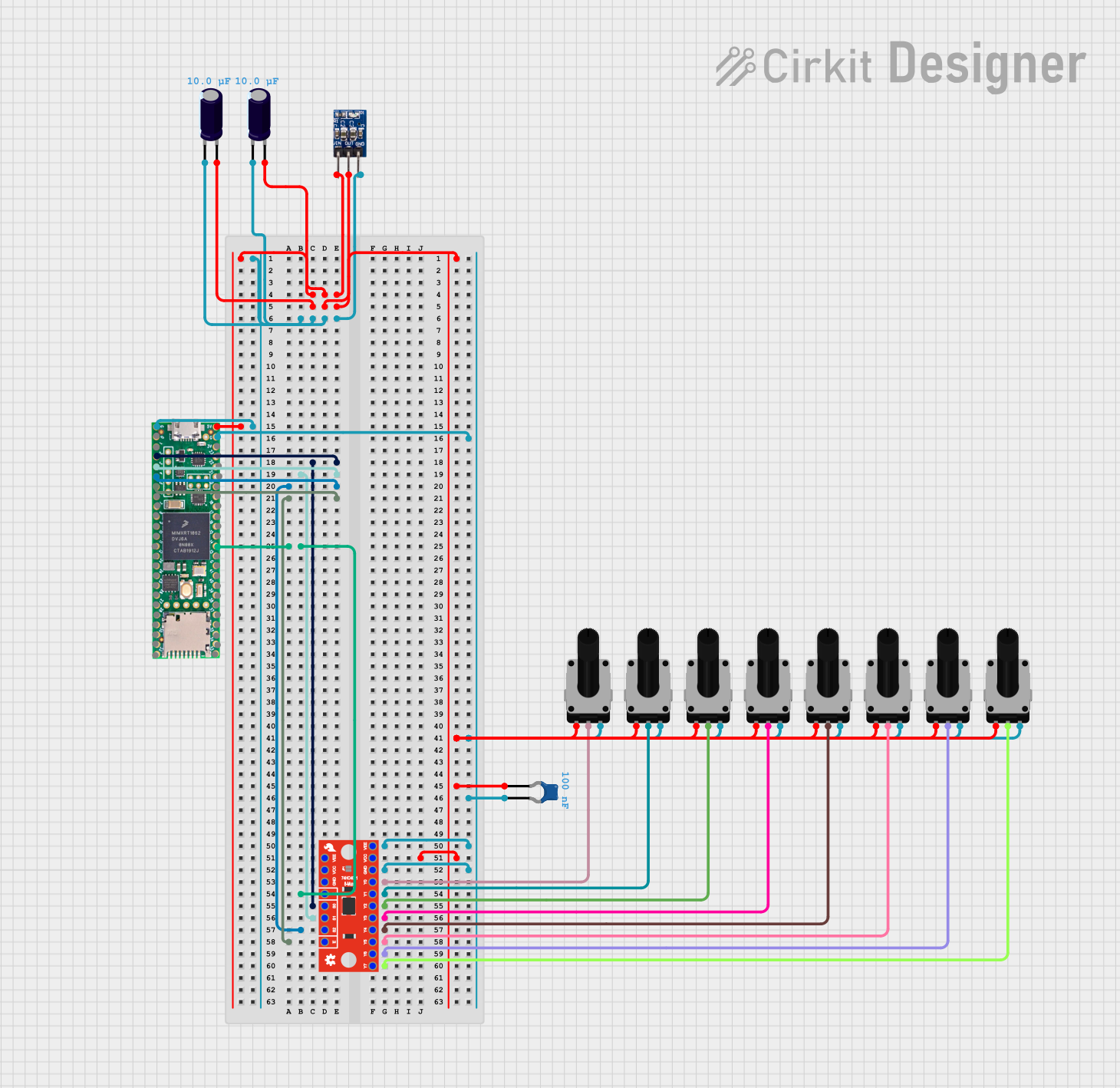
 Open Project in Cirkit Designer
Open Project in Cirkit DesignerExplore Projects Built with MAX4617 Analog Multiplexer

 Open Project in Cirkit Designer
Open Project in Cirkit Designer
 Open Project in Cirkit Designer
Open Project in Cirkit Designer
 Open Project in Cirkit Designer
Open Project in Cirkit Designer
 Open Project in Cirkit Designer
Open Project in Cirkit DesignerCommon Applications:
- Audio and video signal routing
- Data acquisition systems
- Test and measurement equipment
- Communication systems
- Medical instrumentation
Technical Specifications
Key Technical Details:
- Operating Voltage Range: 2.0V to 5.5V
- On-Resistance (RON): 2.5Ω (typical at 5V supply)
- Switching Time: 20ns (typical at 5V supply)
- Bandwidth: 200MHz (typical)
- Low Power Consumption: <1µA (typical in standby mode)
- Signal Range: 0V to VDD
- Operating Temperature Range: -40°C to +85°C
- Package Options: 8-pin µMAX, SOIC
Pin Configuration and Descriptions:
The MAX4617 is an 8-pin device with the following pinout:
| Pin Number | Pin Name | Description |
|---|---|---|
| 1 | IN1 | Analog input channel 1 |
| 2 | IN2 | Analog input channel 2 |
| 3 | IN3 | Analog input channel 3 |
| 4 | IN4 | Analog input channel 4 |
| 5 | COM | Common output (connected to the selected input channel) |
| 6 | GND | Ground |
| 7 | VDD | Positive supply voltage |
| 8 | SEL | Select input (used to choose which input channel is connected to the COM) |
Usage Instructions
How to Use the MAX4617 in a Circuit:
- Power Supply: Connect the VDD pin to a stable power supply within the range of 2.0V to 5.5V. Connect the GND pin to the circuit ground.
- Input Signals: Connect up to four analog signals to the IN1, IN2, IN3, and IN4 pins.
- Output Signal: The selected input channel will be routed to the COM pin, which serves as the output.
- Channel Selection: Use the SEL pin to select the desired input channel:
- Logic LOW (0V): IN1 is connected to COM.
- Logic HIGH (VDD): IN2 is connected to COM.
- Additional logic levels may be used for IN3 and IN4, depending on the control logic.
Important Considerations:
- Ensure that the input signal voltage does not exceed the supply voltage (VDD).
- Minimize noise by using proper decoupling capacitors (e.g., 0.1µF) near the VDD pin.
- Avoid exceeding the maximum ratings for voltage, current, and temperature to prevent damage to the device.
Example: Connecting the MAX4617 to an Arduino UNO
The MAX4617 can be controlled using a microcontroller like the Arduino UNO. Below is an example of how to connect and control the multiplexer:
Circuit Connections:
- Connect the VDD pin of the MAX4617 to the 5V pin of the Arduino.
- Connect the GND pin of the MAX4617 to the GND pin of the Arduino.
- Connect the SEL pin of the MAX4617 to a digital output pin on the Arduino (e.g., pin 7).
- Connect analog signals to IN1, IN2, IN3, and IN4.
- Connect the COM pin to an analog input pin on the Arduino (e.g., A0).
Arduino Code Example:
// Define the SEL pin and COM pin
const int selPin = 7; // Digital pin connected to SEL
const int comPin = A0; // Analog pin connected to COM
void setup() {
pinMode(selPin, OUTPUT); // Set SEL pin as output
Serial.begin(9600); // Initialize serial communication
}
void loop() {
// Select IN1 (SEL = LOW)
digitalWrite(selPin, LOW);
delay(100); // Wait for the signal to stabilize
int signal1 = analogRead(comPin); // Read the signal from IN1
Serial.print("Signal from IN1: ");
Serial.println(signal1);
// Select IN2 (SEL = HIGH)
digitalWrite(selPin, HIGH);
delay(100); // Wait for the signal to stabilize
int signal2 = analogRead(comPin); // Read the signal from IN2
Serial.print("Signal from IN2: ");
Serial.println(signal2);
delay(1000); // Wait before repeating
}
Notes:
- The above code assumes a 2-channel configuration (IN1 and IN2). For 4-channel operation, additional control logic is required.
- Ensure proper grounding and shielding to minimize noise in sensitive applications.
Troubleshooting and FAQs
Common Issues and Solutions:
No Output Signal on COM Pin:
- Verify that the SEL pin is receiving the correct logic level.
- Check the power supply connections (VDD and GND).
- Ensure the input signal is within the specified voltage range.
High Signal Distortion:
- Verify that the input signal frequency is within the bandwidth of the MAX4617.
- Check for proper decoupling capacitors near the VDD pin to reduce noise.
Device Overheating:
- Ensure the input and output currents do not exceed the maximum ratings.
- Verify that the supply voltage is within the specified range.
Intermittent Operation:
- Check for loose or poor connections in the circuit.
- Ensure the SEL pin is not left floating; it should always be driven to a valid logic level.
FAQs:
Q1: Can the MAX4617 handle digital signals?
A1: Yes, the MAX4617 can route digital signals as long as they are within the specified voltage range (0V to VDD).
Q2: What is the maximum signal frequency the MAX4617 can handle?
A2: The MAX4617 has a typical bandwidth of 200MHz, making it suitable for high-frequency signals.
Q3: Can I use the MAX4617 with a 3.3V power supply?
A3: Yes, the MAX4617 operates within a supply voltage range of 2.0V to 5.5V, so it is compatible with 3.3V systems.
Q4: How do I select more than two channels?
A4: For 4-channel operation, additional control logic is required to drive the SEL pin with the appropriate logic levels.
By following this documentation, users can effectively integrate the MAX4617 into their designs and troubleshoot common issues.